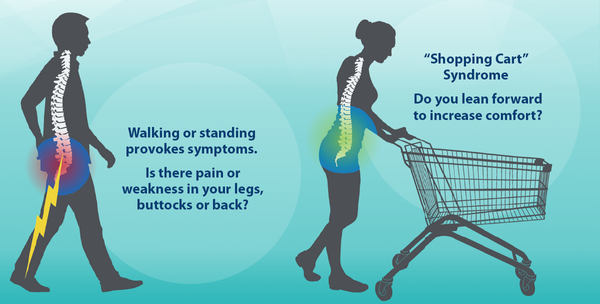Spinal Stenosis
Spinal Stenosis
Helping People Relieve Their Pain Related To Their Spine and Return Them to a Higher Quality of Life
What Causes Spinal Stenosis?
Each of the 33 bones of the spine has a large central canal opening for the spinal cord. Additional openings on each side of the spinal cord called foramens allow the exiting nerves to branch out from the spinal cord to the arms, legs and other parts of the body.
Normally nerve roots have enough room to exit the spinal canal through the foramen. However, with age, degenerative disc disease and trauma, the central canal can narrow and compress the spinal cord and or exiting nerves. Some other conditions such as bulging or herniated discs, calcified ligaments and bone spurs and spinal arthritis may further affect the foramen. This condition can develop anywhere in our spine from cervical to thoracic and is most common in the lumbar region. The average age of patients suffering from spinal and foraminal stenosis is 55 years of age. The disease may affect women and men of varying ages and physical activity levels. The patients at highest risk for stenosis are:
- Obese
- Smokers
- Sedimentary lifestyle
- Lacking proper nutrition
Compression on the spinal and exiting nerve leads to inflammation which can produces many different types of symptoms depending on the severity of the compression.

Symptoms of Spinal Stenosis
The central canal is the space where the exiting nerve exits formed by two facet bones (facet Joint) above and the disc between the vertebral bodies below the exiting nerves. The symptoms experienced among patients can vary depending on the area of the spine affected or compressed. In the cervical (neck) region, symptoms may be experienced in the neck, shoulders and arms down to the fingers. In the lumbar (back) region, symptoms can be felt in the back, buttocks, thighs, knee, calves, feet and toes. The most common symptoms include:
- Dull, sharp or radiating pain
- Weakness or numbness in the extremities
- Sensation of burning or pins and needles
- Difficulty walking or standing straight
- Do you need to lean over the shopping cart
Treatment Options For Spinal Stenosis
As with any spinal condition and depending on the severity of the symptoms, conservative care should always be suggested first before surgical intervention. Typically conservative treatment starts with anti-inflammatory medications or NSAIDS (Non steroidal anti-inflammatory drugs i.e. Ibuprofen), physical therapy, activity modifications and steroid injections.
Spinal Stenosis Surgery
When conservative care is exhausted and the patients are still in pain, surgery is a logical step to relieve the pain. Traditionally, central and lateral recess stenosis is performed open with a large incision in the skin. A laminectomy and or facetectomy are performed to release the pressure on the spinal cord. Unfortunately, this technique is invasive and leads to significant post-operative pain and recovery. With innovation and advances in technology, a less invasive endoscopic technique has been developed to address these painful conditions such as foraminal stenosis.
The Minuteman Technique
The Minuteman® procedure is a minimally invasive surgical technique designed for the fixation and stabilization of the thoracic, lumbar, and sacral spine. This procedure utilizes an interspinous-interlaminar fusion device known as the Minuteman®, which is implanted to provide support while awaiting bony fusion to occur.
Dr. Gabriele Jasper MD's patient walkthrough for performing the Minuteman Spacer procedure involves several key steps:
- Patient Preparation: The patient is positioned prone (face down) on the operating table, and the area of the spine to be treated is sterilized and prepped.
- Anesthesia: Local anesthesia is administered to numb the area around the spine, and sedation will be used to keep the patient comfortable during the procedure.
- Incision: A small incision is made over the targeted vertebrae to access the spine.
- Insertion of the Spacer: The Minuteman Spacer, a small interspinous device, is carefully inserted between the spinous processes of the vertebrae. This device helps to stabilize and decompress the spinal segments.
- Bone Graft Placement: Bone graft material is placed within the spacer to promote stability of the vertebrae over time.
- Closure: The incision is closed with sutures, and the area is bandaged.
- Post-Operative Care: The patient is monitored for a short period before being discharged with instructions for post-operative care, including activity restrictions and follow-up appointments.
This procedure is minimally invasive and aims to provide relief from spinal stenosis and other related conditions by stabilizing the spine and reducing pressure on the nerves.
The Jasper Spine Institute Interventional Pain Management Advantage:
- Less than ¼ inch incision
- Less post-operative pain and recovery than traditional minimally invasive procedur
- Outpatient procedure with patients discharged within 2 hours of surgery
- Return to work within 3-5 days*
At Jasper Spine Institute we listen and work with you to develop a unique treatment regime that addresses your pain and symptoms. Our goal is always to provide solutions whether conservative or surgical so that you are able to return to the quality of life you want without the pain and suffering.
* Always seek your physician’s opinion when it is safe to return to work. Also, light administrative duty is recommended until your physician approves of any physical demands at your place of work.
Contact Us Today
74 Brick Blvd. Brick, NJ 08723
Please take a moment to tell us a little about yourself and your needs. A member from Jasper Spine Institute will contact you as soon as possible. If your needs are urgent please contact us by phone at (732) 262-0700.
